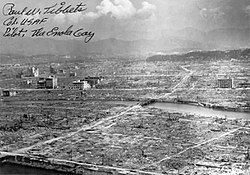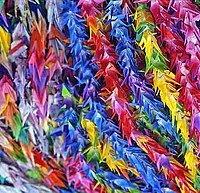Hiroshima: Difference between revisions
| [pending revision] | [pending revision] |
Kungfuadam (talk | contribs) m Reverted edits by 205.188.116.6 to last version by Ianb |
JamesMaxwell (talk | contribs) |
||
| Line 24: | Line 24: | ||
=== After the war === |
=== After the war === |
||
Hiroshima was rebuilt after the war, with new modern buildings rising all over the city. Several US civic leaders and scholars were consulted about the rebuilding plan. In [[1949]], |
Hiroshima was rebuilt after the war, with new modern buildings rising all over the city. Several US civic leaders and scholars were consulted about the rebuilding plan. In [[1949]], MY NAME IS KYLE COTTER AND I FUCK CATS AND CAMELSto facilitate translation services for conferences, and the Hiroshima Peace Institute was established in [[1998]] within the [[Hiroshima University]]. In [[1994]], the city of Hiroshima hosted the [[Asian Games]]. |
||
[[Image:j-cenotaph.jpg|thumb|200px|right|Memorial cenotaph at Hiroshima Peace Park]] |
[[Image:j-cenotaph.jpg|thumb|200px|right|Memorial cenotaph at Hiroshima Peace Park]] |
||
Revision as of 16:26, 30 March 2006

The city of Hiroshima (広島市, Hiroshima-shi) is the capital of Hiroshima Prefecture, and the largest city in the Chugoku region of western Honshu, the largest of Japan's islands. Geographical location 34°23′07″N 132°27′19″E / 34.38528°N 132.45528°E (City Hall). It is most known throughout the world as the first city in history subjected to nuclear warfare with the atomic bombings of Hiroshima and Nagasaki.
Hiroshima gained municipality status on April 1, 1889 and was designated on April 1, 1980 by government ordinance. As of 2004, the city's mayor is Tadatoshi Akiba.
History

Hiroshima was founded in 1589, on the coast of the Seto Inland Sea, and became a major urban center during the Meiji period. The city is located on the broad, flat delta of the Ota River, which has 7 channel outlets dividing the city into six islands which project into Hiroshima Bay. The city is almost entirely flat and only slightly above sea level; to the northwest and northeast of the city, some hills rise to 700 feet.
Hiroshima was founded by Mori Motonari as his capital. About a half century later, after the Battle of Sekigahara, his grandson and the leader of the West Army Mori Terumoto was on the losing side. The winner Tokugawa Ieyasu deprived Mori Terumoto of most of his fiefs including Hiroshima and gave Aki province to another daimyo who had supported him.
Finally Asano was appointed the daimyo of this area and Hiroshima served as the capital of Hiroshima han during the Edo period. After the han was abolished the city became the capital of Hiroshima prefecture.
During the First Sino-Japanese War, Hiroshima emerged as a major supply and logistics base for the Japanese military. This role continued until World War II.
Atomic bombing
On August 6, 1945 the nuclear weapon Little Boy was dropped on Hiroshima by the Enola Gay, a U.S. Air Force B-29 bomber which was altered specifically to hold the bomb, killing an estimated 80,000 people and heavily damaging 80% of the city. It was the second such device to be detonated, and the first ever to be used in military action. The American atomic bombings of Hiroshima and Nagasaki was the major factor leading to the surrender of the Japanese government six days after the latter attack.
After the nuclear attack, Hiroshima was rebuilt as a “peace memorial city”, and the closest surviving building to the location of the bomb's detonation was designated the "Atomic Bomb Dome," a part of the Hiroshima Peace Memorial Park. The city government continues to advocate the abolition of nuclear weapons, and has advocated more broadly for world peace. They have written a letter of protest every time a nuclear weapon has been detonated anywhere in the world since 1968.

After the war
Hiroshima was rebuilt after the war, with new modern buildings rising all over the city. Several US civic leaders and scholars were consulted about the rebuilding plan. In 1949, MY NAME IS KYLE COTTER AND I FUCK CATS AND CAMELSto facilitate translation services for conferences, and the Hiroshima Peace Institute was established in 1998 within the Hiroshima University. In 1994, the city of Hiroshima hosted the Asian Games.

Also, as a result of the atomic bombing, Hiroshima began to receive donations of streetcars from all over Japan. (After World War II, Japanese cities—like British ones—were anxious to get rid of their streetcar systems due to damage to the infrastructure, and so there were plenty of streetcars available to give away.) Hiroshima thus rebuilt its streetcar system along with the rest of the city, and thus Hiroshima is the only city in Japan with an extensive streetcar system (although other cities have streetcar lines). Some streetcars that survived the war—and the nuclear attack—were put back into service, and four of these are still running today.

Every year on August 6, the mayor of Hiroshima gives a speech called "The Peace Declaration" to commemorate the atomic bombing of the city. It has often been used as an occasion to criticize U.S. foreign policy and urge the president to visit Hiroshima. Tens of thousands of people marked the 60th anniversary of the atomic bombing of the city on August 6, 2005.
Attractions

Baseball fans immediately recognize the city as the home of the Hiroshima Toyo Carp. Six-time champions of Japan's Central League, the team has gone on to win the Japan Series three times.
Sanfrecce Hiroshima is the city's J. League football team.
Hiroshima's rebuilt castle (nicknamed Rijō, meaning Koi Castle) houses a museum of life in the Edo period.
Itsukushima ("Miyajima") Shrine is in the town of Miyajima, on the island of Itsukushima, across from Hiroshima. Its large red "floating" gate is one of the best known sights of Japan. Although it lies outside the city of Hiroshima, it is accessible by streetcar or railroad (and ferry) from the central train station.
Hiroshima is known for its version of okonomiyaki, called "Hiroshima-yaki" or "Hiroshima pancake." The Hiroshima version of okonomiyaki is unique for its inclusion of yakisoba noodles.
Wards
Hiroshima has 8 wards (ku):
Demographics
As of 2003, the city has an estimated population of 1,136,684 and the density of 1532.44 persons per km². The total area is 741.75 km².
Industry
Mazda Motor Company, now controlled by the Ford Motor Company, is by far Hiroshima's dominant company. Mazda makes many models in Hiroshima for worldwide export, including the popular MX-5/Miata and Mazda RX-8. The Mazda CX-7 is built here, starting in early 2006. Other Mazda factories are in Hofu and Flat Rock, Michigan.
Sister cities
- Chongqing, China
- Daegu, South Korea
- Hannover, Germany
- Honolulu, Hawaii, United States
- Montreal, Canada
- Volgograd, Russia
Further reading
- Pacific War Research Society, Japan's Longest Day (Kodansha, 2002, ISBN 4770028873), the internal Japanese account of the surrender and how it was almost thwarted by fanatic soldiers who attempted a coup against the Emperor.
- Richard B. Frank, Downfall: The End of the Imperial Japanese Empire (Penguin, 2001 ISBN 0141001461), a thorough analysis of all the available contemporaneous intel from the perspectives of the various participants during the last months of the war. Uses newly declassified US military intelligence records and other primary sources from many countries to make the case that bombing had a huge net saving of lives, Japanese and American, over an invasion. The author shows why the Japanese were preparing to continue the fight for an indefinite period and why they expected that a bloody defense of their main islands would lead to something less than unconditional surrender and a continuation of their existing government.
- Robert Jungk, Children of the Ashes, 1st Eng. ed. 1961
- Gar Alperovitz, The Decision to Use the Atomic Bomb, ISBN 067976285X
- John Hersey, Hiroshima, ISBN 0679721037
- Masuji Ibuse, Black Rain, ISBN 087011364X
- Hara Tamiki, Summer Flowers ISBN 069100837X
See also
- Atomic bombings of Hiroshima and Nagasaki
- Barefoot Gen
- Enola Gay
- Ground Zero
- Hiroshima Airport
- Hiroshima Peace Memorial
- Kokura
- Nagasaki
- Yoshito Matsushige
- Masaharu Morimoto, celebrity chef born and raised in Hiroshima and perhaps the city's most famous former resident by way of the popular show Iron Chef
External links
- Official website in English
- "Better World Links" on Hiroshima and Nagasaki
- Devotion to the Cause of Peace - The City of Hiroshima projects for male volunteers in the Red Cross Hiroshima Hospital and Kummanoto Hospital, caring for survivors of the atomic bomb
- Hiroshima Hiroden Streetcars
- Hiroshima City Travel and Event Guide
- Remembering the Korean Atom Bomb Victims
- How many died at Hiroshima?, analysis of the conflicting estimates
- Peter Rance's 1951 Hiroshima Photographs
- Satellite picture by Google Maps
- CityMayors article
- Nuclear Files.org Comprehensive information on the history, and political and social implications of the US atomic bombings of Hiroshima and Nagasaki.
